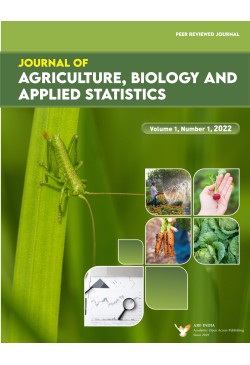
Journal of Agriculture, Biology and Applied Statistics
Frequency :Bi-Annual
ISSN :2583-4185
Peer Reviewed Journal
Effect of Seed Bio-priming with Cold Tolerant Pseudomonas fluorescens and Soil Application of Cow Urine on Germination, growth and Nutrient Uptake in Pea
Two pot experiments were carried out at College of Forestry, Ranichauri, Tehri Garhwal, Uttarakhand (India) during 2018-2019 to investigate the effect of seed biopriming with cold tolerant Pseudomonas fluorescens and soil application of cow urine on germination and growth of pea. Experiments consisted of eight treatments viz; control (T1), lime + RDF @ 20:30:30 kg/ha (T2), soil application of 10% cow urine + RDF (T3), seed bio-priming with cold tolerant Pseudomonas fluorescens + RDF (T4), FYM @ 10 t/ha + RDF (T5), FYM @ 10 t/ha + seed bio-priming with cold tolerant Pseudomonas fluorescens + RDF (T6), 10 % cow urine + seed bio-priming with cold tolerant Pseudomonas fluorescens + RDF (T7) and 10 % cow urine + FYM @ 10 t/ha + RDF (T8) replicated thrice. The results revealed that seed bio-priming with cold tolerant Pseudomonas fluorescens + RDF recorded significantly higher germination percentage and seedling growth at 25 DAS in pot experiment I. Also the application of 10 % cow urine + FYM @ 10 t/ha + RDF had maximum value for growth, yield attributes and seed yield in pot experiment II. These findings suggested the role of cold tolerant Pseudomonas fluorescens in improving the germination of pea. Also the use of cow urine along with FYM was found more efficient in increasing the growth and yield of pea.
Singh, A., Rawat, D., Gautam, R., & Yadav, S. (2023).Effect of Seed Bio-priming with Cold Tolerant Pseudomonas fluorescens and Soil Application of Cow Urine on Germination, growth and Nutrient Uptake in Pea. Journal of Agriculture, Biology and Applied Statistics. Vol. 2, No. 1, pp. 1-9. https://DOI:10.47509/JABAS.2023.v02i01.01
A Study on Trend of Wood Fuel Production in World
The primary biomass energy source is wood fuel, which is important for human economic and social development worldwide. Wood fuels come from a variety of sources, including forests, trees found outside of forests, other areas that are forested, byproducts of the processing of wood, processed wood-based fuels, and post-consumer recovered wood. The present study was conducted to understand the per se performance and trend analysis of wood fuel production in the world. The secondary data on production of Wood Fuel was collected from FAO for the period of 1961 - 2020. The top five countries such as India, China mainland, Brazil, Ethiopia and Democratic Republic of Congo were selected for analysis based on total production of wood fuel. Results shows that the estimated production of nonconiferous wood fuel is higher than coniferous wood fuel in all the five countries. In case of India, wood fuel production shows increasing rate and rapidly except at some period, in case of China, there is a gradual decrease in wood fuel production in recent decades which may be due to increase in per-capita income shifted to other sources. There is a sudden decrease in wood fuel production in case of Brazil. Whereas there is an exponential increase in wood fuel production of Ethiopia. This shows the change in the trend along the decade, the decreasing trend may be due to availability of rich conventional sources of energy and increasing trend may be ascribed to crisis in conventional energy sources and sustainable environmental development perspective.
Modeling and Forecasting of Lentil in India
Keywords: Area, ARIMA, GARCH,trend, modelling, forecasting, production and productivity.
Assessment of Botanical Interventions for Effective Management of Papaya Leaf Curl Disease: A Step towards Sustainable Plant Virus Control
Papaya (Carica papaya) is a prominent tropical fruit crop grown in various tropical and subtropical regions, including Bangladesh, where it serves as both a vegetable and a dessert fruit. With its rich content of vitamin C, antioxidants, phytohormones, and flavonoids, papaya is highly valued. However, the production of this crop faces challenges from numerous biotic and abiotic factors, including diseases and pests. Among the diseases affecting papaya, viral infections pose the greatest threat, leading to substantial yield losses of up to 90-100%. Papaya leaf curl disease has emerged as a significant issue in Bangladesh, with transmission occurring through the whitefly insect, Bemisia tabaci. Current disease management practices heavily rely on expensive and environmentally harmful chemical pesticides, necessitating the exploration of eco-friendly approaches. In this study, we conducted an experiment to evaluate the efficacy of several botanical treatments against papaya leaf curl disease. Seven treatments, including Bioclean (d-Limonene 5%), Biotrine (Matrine 0.5%), K-Mite (Matrine 0.5%), Neem Oil (0.5%), Chitosan (0.01%), Chemical (Chloropiriphos 50% + Cypermethrin 5%), and a control, were applied to two papaya cultivars, Red Queen (RG) and Red Top (RT). Plant height, disease incidence and severity, as well as flower and fruit counts, were assessed at various time points. Statistical analysis revealed that Chitosan-treated plants (0.01%) exhibited significant growth promotion compared to the control. During
Mofazzal Hossain, Motasin Hossain, Mohammad S. Monjil & K.M.G. Dastogeer (2023). Assessment of Botanical Interventions for Effective Management of Papaya Leaf Curl Disease: A Step towards Sustainable Plant Virus Control. Journal of Agriculture, Biology and Applied Statistics. Vol. 2, No. 1, pp. 45-61. https://DOI:10.47509/JABAS.2023.v02i01.04
Assessment of Genetic Diversity of Tectona grandis Linn. F. using SSR markers